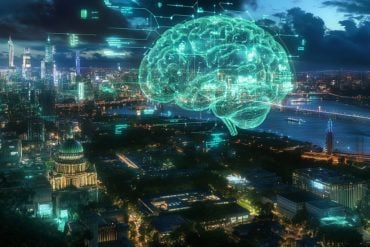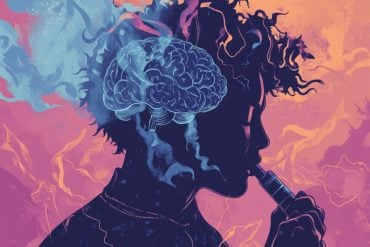Summary: DHA treatment reduced the size of the damaged brain area and initiated a repair mechanism in animal models of stroke. DHA affected the levels of MANF and TREM2, two proteins critical for communication between brain cells.
Source: LSU
Research led by Nicolas Bazan, MD, PhD, Boyd Professor and Director of the Neuroscience Center of Excellence at LSU Health New Orleans School of Medicine, and Ludmila Belayev, MD, LSU Health New Orleans Professor of Neuroscience, Neurology and Neurosurgery, has unlocked a key fundamental mechanism in the communication between brain cells when confronted with stroke. They report that DHA not only protected neuronal cells and promoted their survival, but also helped maintain their integrity and stability. The discovery provides potential new clinical targets and specific molecules for the treatment of ischemic stroke and other cardiovascular diseases. Their findings are published online in CNS Neuroscience & Therapeutics.
Brain cells talk to one another. This synchronized cell-to-cell crosstalk regulates neuroinflammation and the immune system, which are activated in the brain at the onset of stroke, Alzheimer’s, Parkinson’s, and other diseases. The researchers found that in the model of stroke, docosahexaenoic acid (DHA) affects the levels of two proteins crucial to communication between brain cells — mesencephalic astrocyte-derived neurotrophic factor (MANF) and triggering receptor expressed on myeloid cells-2 (TREM2). They discovered that treatment with DHA reduced the size of the damaged brain area, initiated repair mechanisms and greatly improved neurological and behavioral recovery. These findings provide a major conceptual advance of broad relevance for neuronal cell survival, brain function and, particularly, stroke and neurodegenerative diseases.
DHA is made from omega-3 very long chain polyunsaturated fatty acids (VLC-PUFAs,n-3). It is found in fatty, cold-water fish like salmon. Among other benefits, DHA is essential for normal brain function in adults and for the growth and development of the brain in babies.
“Our findings contribute greatly to our understanding of cellular interactions engaging neurons, astrocytes, and microglia to sustain synaptic circuitry, set neurogenesis in motion, and initiate restoration to pathological derangements,” notes Dr. Bazan, who also holds the Ernest C. and Ivette C. Villere Chair at LSU Health New Orleans.

These findings advance the understanding of how the complexity and resiliency of the human brain is sustained, mainly when confronted with adversities as in stroke. A key factor is how neurons communicate among themselves. These novel molecules participate in delivering messages to the overall synaptic organization to ensure the accurate flow of information through neuronal circuits.
“We know how neurons make synaptic connections with other neurons; however, these connections have to be malleable in order to change to the appropriate strength through experience,” explains Dr. Belayev.
“It’s like an orchestra,” says Bazan. “You need a conductor, and this is the role that DHA plays. Such a large-scale complexity first requires violinists, or in this case, synapses, which are highly sensitive sites of stroke injury that become messengers to target vulnerable cells.”
Co-authors include Sung-Ha Hong, Raul S. Freitas, Hemant Menghani, Shawn J. Marcell, Larissa Khoutorova, Pranab K. Mukherjee, and Reinaldo B. Oria. Dr. Menghani was supported by the Department of Pediatrics Hematology-Oncology Section at LSU Health New Orleans and Children’s Hospital of New Orleans. Raul S. Freitas is a graduate student from the Laboratory of the Biology of Tissue Healing, Ontogeny and Nutrition, Department of Morphology and Institute of Biomedicine, School of Medicine, Federal University of Ceara, Fortaleza, Brazil. Shawn J. Marcell is an LSU Health New Orleans medical student.
Funding: The research was supported by grants from the National Institute of Neurological Disorders and Stroke 1R01NS109221 and 1R01NS104117.
About this neuroscience research article
Source:
LSU
Contacts:
Leslie Capo – LSU
Image Source:
The image is in the public domain.
Original Research: Open access
“DHA modulates MANF and TREM2 abundance, enhances neurogenesis, reduces infarct size, and improves neurological function after experimental ischemic stroke” by Ludmila Belayev, Sung‐Ha Hong, Raul S. Freitas, Hemant Menghani, Shawn J. Marcell, Larissa Khoutorova, Pranab K. Mukherjee, Madigan M. Reid, Reinaldo B. Oria, Nicolas G. Bazan. CNS Neuroscience & Therapeutics.
Abstract
DHA modulates MANF and TREM2 abundance, enhances neurogenesis, reduces infarct size, and improves neurological function after experimental ischemic stroke
Aims
Mesencephalic astrocyte‐derived neurotrophic factor (MANF) is a secretory neurotrophic factor protein that promotes repair after neuronal injury. The microglia cell surface receptor (triggering receptor expressed on myeloid cells‐2; TREM2) regulates the production of pro‐ and antiinflammatory mediators after stroke. Here, we study MANF and TREM2 expression after middle cerebral artery occlusion (MCAo) and explore if docosahexaenoic acid (DHA) treatment exerts a potentiating effect.
Methods
We used 2 hours of the MCAo model in rats and intravenously administered DHA or vehicle at 3 hours after the onset of MCAo. Neurobehavioral assessment was performed on days 1, 3, 7, and 14; MANF and TREM2 expression was measured by immunohistochemistry and Western blotting.
Results
MANF was upregulated in neurons and astrocytes on days 1, 7, and 14, and TREM2 was expressed on macrophages in the ischemic penumbra and dentate gyrus (DG) on days 7 and 14. DHA improved neurobehavioral recovery, attenuated infarct size on days 7 and 14, increased MANF and decreased TREM2 expression in ischemic core, penumbra, DG, and enhanced neurogenesis on Day 14.
Conclusion
MANF and TREM2 protein abundance is robustly increased after MCAo, and DHA treatment potentiated MANF abundance, decreased TREM2 expression, improved neurobehavioral recovery, reduced infarction, and provided enhanced neuroprotection.






